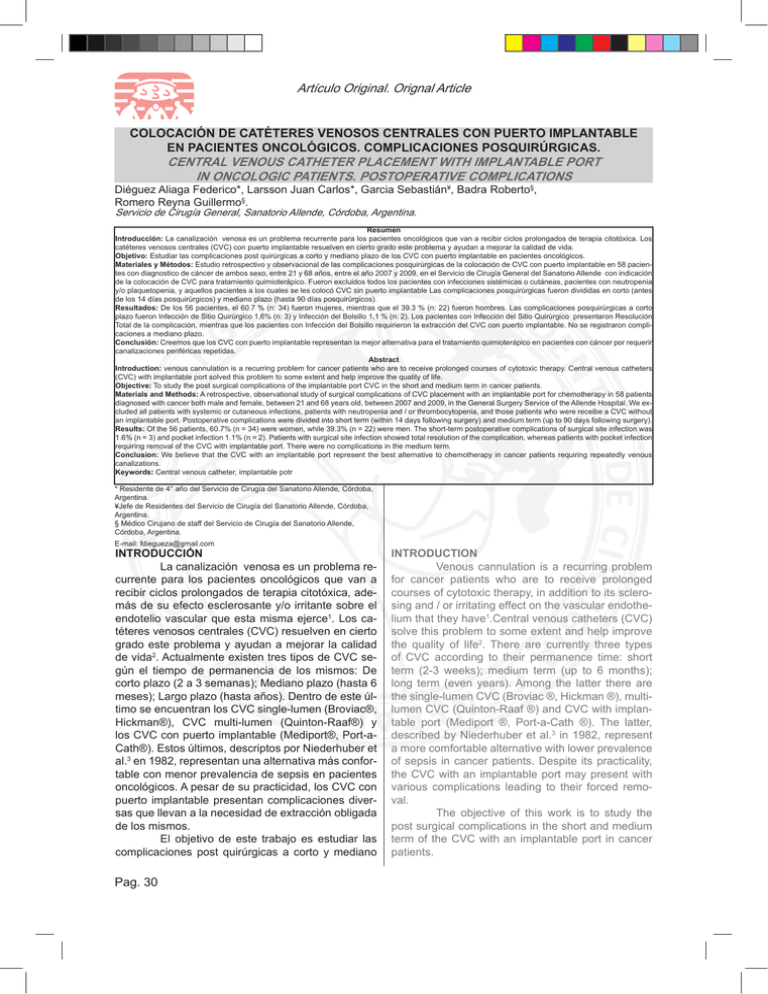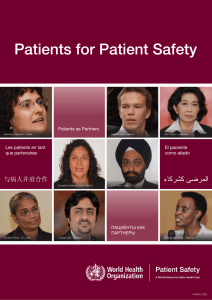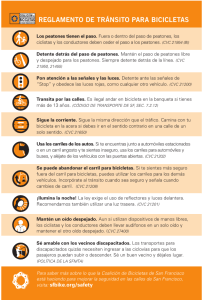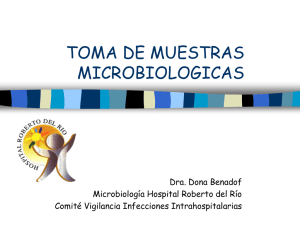Pag. 30 Artículo Original. Orignal Article COLOCACIÓN DE
Anuncio

Artículo Original. Orignal Article COLOCACIÓN DE CATÉTERES VENOSOS CENTRALES CON PUERTO IMPLANTABLE EN PACIENTES ONCOLÓGICOS. COMPLICACIONES POSQUIRÚRGICAS. CENTRAL VENOUS CATHETER PLACEMENT WITH IMPLANTABLE PORT IN ONCOLOGIC PATIENTS. POSTOPERATIVE COMPLICATIONS Diéguez Aliaga Federico*, Larsson Juan Carlos*, Garcia Sebastián¥, Badra Roberto§, Romero Reyna Guillermo§. Servicio de Cirugía General, Sanatorio Allende, Córdoba, Argentina. Resumen Introducción: La canalización venosa es un problema recurrente para los pacientes oncológicos que van a recibir ciclos prolongados de terapia citotóxica. Los catéteres venosos centrales (CVC) con puerto implantable resuelven en cierto grado este problema y ayudan a mejorar la calidad de vida. Objetivo: Estudiar las complicaciones post quirúrgicas a corto y mediano plazo de los CVC con puerto implantable en pacientes oncológicos. Materiales y Métodos: Estudio retrospectivo y observacional de las complicaciones posquirúrgicas de la colocación de CVC con puerto implantable en 58 pacientes con diagnostico de cáncer de ambos sexo, entre 21 y 68 años, entre el año 2007 y 2009, en el Servicio de Cirugía General del Sanatorio Allende con indicación de la colocación de CVC para tratamiento quimioterápico. Fueron excluidos todos los pacientes con infecciones sistémicas o cutáneas, pacientes con neutropenia y/o plaquetopenia, y aquellos pacientes a los cuales se les colocó CVC sin puerto implantable Las complicaciones posquirúrgicas fueron divididas en corto (antes de los 14 días posquirúrgicos) y mediano plazo (hasta 90 días posquirúrgicos). Resultados: De los 56 pacientes, el 60.7 % (n: 34) fueron mujeres, mientras que el 39.3 % (n: 22) fueron hombres. Las complicaciones posquirúrgicas a corto plazo fueron Infección de Sitio Quirúrgico 1,6% (n: 3) y Infección del Bolsillo 1,1 % (n: 2). Los pacientes con Infección del Sitio Quirúrgico presentaron Resolución Total de la complicación, mientras que los pacientes con Infección del Bolsillo requirieron la extracción del CVC con puerto implantable. No se registraron complicaciones a mediano plazo. Conclusión: Creemos que los CVC con puerto implantable representan la mejor alternativa para el tratamiento quimioterápico en pacientes con cáncer por requerir canalizaciones periféricas repetidas. Abstract Introduction: venous cannulation is a recurring problem for cancer patients who are to receive prolonged courses of cytotoxic therapy. Central venous catheters (CVC) with implantable port solved this problem to some extent and help improve the quality of life. Objective: To study the post surgical complications of the implantable port CVC in the short and medium term in cancer patients. Materials and Methods: A retrospective, observational study of surgical complications of CVC placement with an implantable port for chemotherapy in 58 patients diagnosed with cancer both male and female, between 21 and 68 years old, between 2007 and 2009, in the General Surgery Service of the Allende Hospital. We excluded all patients with systemic or cutaneous infections, patients with neutropenia and / or thrombocytopenia, and those patients who were receibe a CVC without an implantable port. Postoperative complications were divided into short term (within 14 days following surgery) and medium term (up to 90 days following surgery). Results: Of the 56 patients, 60.7% (n = 34) were women, while 39.3% (n = 22) were men. The short-term postoperative complications of surgical site infection was 1.6% (n = 3) and pocket infection 1.1% (n = 2). Patients with surgical site infection showed total resolution of the complication, whereas patients with pocket infection requiring removal of the CVC with implantable port. There were no complications in the medium term. Conclusion: We believe that the CVC with an implantable port represent the best alternative to chemotherapy in cancer patients requiring repeatedly venous canalizations. Keywords: Central venous catheter, implantable potr * Residente de 4° año del Servicio de Cirugía del Sanatorio Allende, Córdoba, Argentina. ¥Jefe de Residentes del Servicio de Cirugía del Sanatorio Allende, Córdoba, Argentina. § Médico Cirujano de staff del Servicio de Cirugía del Sanatorio Allende, Córdoba, Argentina. E-mail: [email protected] INTRODUCCIÓN La canalización venosa es un problema recurrente para los pacientes oncológicos que van a recibir ciclos prolongados de terapia citotóxica, además de su efecto esclerosante y/o irritante sobre el endotelio vascular que esta misma ejerce1. Los catéteres venosos centrales (CVC) resuelven en cierto grado este problema y ayudan a mejorar la calidad de vida2. Actualmente existen tres tipos de CVC según el tiempo de permanencia de los mismos: De corto plazo (2 a 3 semanas); Mediano plazo (hasta 6 meses); Largo plazo (hasta años). Dentro de este último se encuentran los CVC single-lumen (Broviac®, Hickman®), CVC multi-lumen (Quinton-Raaf®) y los CVC con puerto implantable (Mediport®, Port-aCath®). Estos últimos, descriptos por Niederhuber et al.3 en 1982, representan una alternativa más confortable con menor prevalencia de sepsis en pacientes oncológicos. A pesar de su practicidad, los CVC con puerto implantable presentan complicaciones diversas que llevan a la necesidad de extracción obligada de los mismos. El objetivo de este trabajo es estudiar las complicaciones post quirúrgicas a corto y mediano Pag. 30 INTRODUCTION Venous cannulation is a recurring problem for cancer patients who are to receive prolonged courses of cytotoxic therapy, in addition to its sclerosing and / or irritating effect on the vascular endothelium that they have1.Central venous catheters (CVC) solve this problem to some extent and help improve the quality of life2. There are currently three types of CVC according to their permanence time: short term (2-3 weeks); medium term (up to 6 months); long term (even years). Among the latter there are the single-lumen CVC (Broviac ®, Hickman ®), multilumen CVC (Quinton-Raaf ®) and CVC with implantable port (Mediport ®, Port-a-Cath ®). The latter, described by Niederhuber et al.3 in 1982, represent a more comfortable alternative with lower prevalence of sepsis in cancer patients. Despite its practicality, the CVC with an implantable port may present with various complications leading to their forced removal. The objective of this work is to study the post surgical complications in the short and medium term of the CVC with an implantable port in cancer patients. Rev. Arg. Res. Cir 2012; 17(2):30-33. plazo de los CVC con puerto implantable en pacientes oncológicos. 39% 61% Femenino Masculino MATERIALS AND METHODS Retrospective and observational study of postoperative complications of CVC placement with an implantable port in 58 patients with a diagnosis of cancer, of both gender, between 21 and 68 years old, between 2007 and 2009, in the General Surgery Department of the Allende Hospital by medical history review and personal meeting following a preformed questionnaire.All patients were referred by the oncology service of the same hospital for the CVC placement for chemotherapy. We excluded all patients with systemic or cutaneous infections, patients with neutropenia and / or thrombocytopenia, and those patients who were placed CVC without implantable port. All patients underwent, before surgery, laboratory work up(cytologic examination, coagulation tests and platelet count). All patients used Lexel ® Titanium Port with radiopaque 9 Fr catheter. The placement was performed under local anesthesia in the operating room (50 cc with Epinephrine Lidocaine 2% diluted in 50 ml saline).Canalization of the internal jugular vein (IJV) was performed using the Seldinger technique. In case of technical difficulty (several failed attempts vein cannulation), dissection and phlebotomy was performed of the IJV. We performed a subcutaneous pocket in the right subclavian region. Tunneling was performed to the site of canalization of IJV with the placement of a 9F catheter. An Implantable device was placed in its pocket and fixed with 3-0 Vicryl ® sutures to the pectoral fascia. Radiographic control was conducted assuring its atrial location of the tip of the catheter and later heparinization of both the device and catheter with diluted 1% sodic heparin with saline solution. All patients received antibiotic prophylaxis with cefazolin before the procedure 2 g and two further doses of 1 gr. We performed surgical site care every 72 hours performed by nurses and heparinization of CVC and of the implantable port with 2 cubic centimeter of 10% sodic heparin after Pag. 31 Artículo Original Original Articles MATERIAL Y MÉTODOS Estudio retrospectivo y observacional de las complicaciones posquirúrgicas de la colocación de CVC con puerto implantable en 58 pacientes con diagnostico de cáncer, de ambos sexo, entre 21 y 68 años, entre el año 2007 y 2009, en el Servicio de Cirugía General del Sanatorio Allende mediante revisión de Historias Clínicas y entrevista personal siguiendo un cuestionario confeccionado previamente. Todos los pacientes fueron derivados por el Servicio de Oncología del mismo Sanatorio con indicación de la colocación de CVC para tratamiento quimioterápico. Fueron excluidos todos los pacientes con infecciones sistémicas o cutáneas, pacientes con neutropenia y/o plaquetopenia, y aquellos pacientes a los cuales se les colocó CVC sin puerto implantable. A todos los pacientes se le realizó, previo a la intervención, estudios de laboratorio (citológico completo, pruebas de coagulación, recuento de plaquetas). En todos los pacientes se utilizó set Lexel® Titanium Port con catéter radio opaco de 9 Fr. La colocación del catéter se realizó en quirófano con anestesia local (50 cc de Lidocaína con Epinefrina al 2% diluida en 50 cc de Solución Fisiológica). Se canalizó la vena yugular interna (VYI) mediante técnica de Seldinger. En casos de dificultad técnica (varios intentos fallidos de canalización de la vena), se realizó disección y flebotomía de la VYI. Se realizó bolsillo en TCS de la región subclavia, anterior del hemitórax derecho. Se realizó tunelización hasta sitio de canalización de VYI con pasaje de catéter de 9F e introducción del mismo en VYI. SE colocó el tambor implantable en bolsillo y se lo fijo con puntos de Vicryl® 3-0 a fascia pectoral. Se realizo control radiográfico de localización atrial de punta del catéter y heparinización del tambor y catéter con Heparina Na diluida al 1% en Solución fisiológica. Todos los pacientes recibieron antibiotico profilaxis previo al procedimiento con cefazolina 2 gr y dos dosis posteriores de 1 gr. Se realizó curación de sitio quirúrgica cada 72 hs por personal de enfermería y heparinización del CVC y tambor con 2 cc de heparina Na al 10% posterior a cada ciclo de quimioterapia. Todos los pacientes recibieron un seguimiento de 90 días. Las complicaciones posquirúrgicas fueron divididas en corto (antes de los 14 días posquirúrgicos) y mediano plazo (hasta 90 días posquirúrgicos). Se definió como “Infección del bolsillo del puerto” a la induración, eritema y dolor alrededor del sitio quirúrgico con cultivos positivos de las muestras del material aspirado del bolsillo infectado. La “infección del sitio quirúrgico” fue definida como eritema y tumefacción del sitio de punción de la aguja del puerto. “Sepsis a partir del puerto” se definió Artículo Original. Orignal Article como 2 hemocultivos con flora de la piel con criterios clínicos de sepsis. Se definió “Migración del CVC” al hallazgo radiográfico del catéter en localización no aurícula derecha. “Obstrucción del catéter” se definió como la imposibilidad de administrar fluidos o extraer sangre a través del catéter por cualquier causa (mal posición de la punta del catéter contra la pared de la vena, pinzamiento del catéter entre la clavícula y la primera costilla, trombosis del catéter).4 Se realizó un análisis estadístico descriptivo de la frecuencia y distribución de las complicaciones a corto y mediano plazo de los CVC con puerto implantable. RESULTADOS Se analizaron un total de 58 pacientes, de los cuales se excluyeron 2 por presentar neutropenia al momento de la intervención. De los 56 pacientes, el 60.7 % (n: 34) fueron mujeres, mientras que el 39.3 % (n: 22) fueron hombres. La edad promedio fue de 50 años, con una mínima de 23 y una máxima de 68 años (rango: 45). Todos los pacientes presentaron como antecedente personal el diagnóstico de cáncer, de los cuales el 38% fue Ca de Mama (n: 21), 24% Ca de Colon (n: 13), 15% Linfoma (n: 9), 10% Ca de Pulmón (n: 6), 4% Melanoma (n: 2) y 9% Otros (n: 5). Presentaron antecedente de Quimioterapia previa el 54% de los pacientes (n: 30), Radioterapia 7% (n: 4), Quimio y Radioterapia 21% (n: 12), y No recibieron tratamiento el 18% de los pacientes (n: 10). Las complicaciones posquirúrgicas a corto plazo fueron Infección de Sitio Quirúrgico 5,3% (n: 3), Infección del Bolsillo 3,5 % (n: 2) y Trombosis del Catéter 1,8% (n: 1). Los pacientes con Infección del Sitio Quirúrgico se presentaron en el día 4, 6 y 9 postquirúrgico (corto plazo) y presentaron Resolución Total de la complicación con administración de cefalosporina de primera generación por 7 días. Los pacientes con Infección del Bolsillo tuvieron su complicación en el día 20 y 45 (mediano plazo). La Trombosis del Catéter se presentó en el día 28 (mediano plazo). Los dos últimos requirieron la extracción del CVC con puerto implantable (5,3 %). No se registraron complicaciones a mediano plazo. DISCUSIÓN Desde que Niederhuber et al1 desarrolló el CVC con puerto implantable en el año 1982, estos han sido utilizados ampliamente para la administración prolongada de drogas quimioterápicas en pacientes con cáncer. Los CVC con puerto implantable mejoran la calidad de vida de los pacientes con poca morbilidad mediante un procedimiento de simple realización, bajo costo y fácil mantenimiento. Pag. 32 each chemotherapy cycle. All patients were followed for 90 days.Postoperative complications were divided into short (within 14 days following surgery) and medium term (up to 90 days following surgery). Was defined as "the port pocket infection" the induration, erythema and pain around the surgical site with positive cultures of the aspirate samples from the infected pocket. "Surgical site infection" was defined as erythema and swelling of the puncture site of the needle port. "Sepsis from port" was defined as two blood cultures with skin flora with clinical criteria of sepsis. We defined "Migrating the CVC" to the radiographic migration finding of the CVC in a different location to the right atrium. "Catheter obstruction" was defined as the inability to administer fluids or the inability to withdraw blood through the catheter for any reason (wrong position of the catheter tip against the wall of the vein, clamp the catheter between the clavicle and the first rib, thrombosis of it) .4 We performed a descriptive analysis of the frequency and distribution of complications in the short and medium term of CVC with an implantable port placement. RESULTS We analyzed a total of 58 patients, of whom 2 were excluded due to neutropenia present at the time of the intervention.Of the 56 patients, 60.7% (n = 34) were women, while 39.3% (n = 22) were men. The average age was 50 years, with a minimum of 23 and maximum of 68 years (range: 45). All patients presented the personal history of cancer diagnosis, of which 38% was Breast Cancer (n = 21), 24% of Colon Cancer (n = 13), 15% lymphoma (n = 9), 10% Lung Cancer (n = 6), 4% Melanoma (n = 2) and 9% Other (n = 5). Had a history of prior chemotherapy, 54% of patients (n = 30), Radiotherapy 7% (n = 4), chemotherapy and radiotherapy 21% (n = 12), and no treatment 18% of patients (n: 10). The short-term postoperative complications of surgical site infection was 5.3% (n = 3), pocket infection 3.5% (n = 2) and 1.8% catheter thrombosis (n = 1).Patients with surgical site infection occurred on day 4, 6 and 9 after surgery (short term) and showed total resolution of the complication with administration of first-generation cephalosporin for 7 days. Patients had their pocket infection complication on day 20 and 45 (medium term). Catheter thrombosis occurred in the 28th day (medium term). The last two required the removal of CVC with implantable port (5.3%). There were no complications in the medium term. DISCUSSION Since Niederhuber et al.1 developed the CVC La morbilidad de este procedimiento es principalmente la infección asociada al implante, como pudimos observar en este estudio en un porcentaje total del 8,5 %, como la Infección del Sitio quirúrgico y del Bolsillo del implante, siendo importante el diagnóstico diferencial de los estos, ya que la resolución del primero es total con sólo administración de ATB de amplio espectro, mientras que el segundo requiere la extracción obligada del CVC. Conocer esto es importante, ya que extremando las medidas de asepsia y antisepsia, se puede disminuir este porcentaje5. Al igual que en el estudio de Fisher L y col., las complicaciones infecciosas son la principal causa de extracción del cateter4 Como complicación aislada se observo Trombosis del Catéter, situación que obligó la extracción del catéter. En otros estudios, se observaron mayores porcentajes de trombosis, llegando hasta 10 %5,6,7. Es importante tener en cuenta que la mayoría de las veces ésta es asintomática8, 9. Yeste Sánchez L y col10 obtuvieron mejores resultados en cuanto a complicaciones infecciosas, con sólo un 2% en 560 pacientes, pero presentaron un 2,3% de complicaciones por obstrucción del catéter. A su vez, es importante conocer el resto de las complicaciones posibles descriptas en otras series11, que nosotros no observamos, tal vez por no incluir un número mayor de pacientes o utilizar criterios de exclusión amplios. En nuestro trabajo no se observaron complicaciones a mediano plazo, tal vez porque algunas de las posibles complicaciones esperadas requieren mayor tiempo para producirse. Por dificultades técnicas y dado que muchas veces la patología de base de los pacientes produce la aparición de nuevas variables a tener en cuenta, no se analizaron las complicaciones surgidas más allá de los 90 días. CONCLUSIÓN Creemos que los CVC con puerto implantable representan la mejor alternativa para el tratamiento quimioterápico en pacientes con cáncer por requerir canalizaciones periféricas repetidas. La colocación de estos catéteres es de simple técnica y presenta escaso número de complicaciones de fácil resolución a corto y mediano plazo. with an implantable port in 1982, these have been used extensively for the prolonged administration of chemotherapeutic drugs in cancer patients.The CVC with an implantable port improve the quality of life of patients with low morbidity, simple, low cost procedure which also is easy to maintain. The morbidity of this procedure is mainly associated with implant infection, as we observed in this study in a total of 8.5%, as the surgical site infection and of the implant pocket, being important the differential diagnosis of these, since the first have a complete resolution with broad spectrum antibiotics, while the latter requires the forced extraction of the CVC. Knowing this fact is important because taking extreme aseptic and antiseptic measures may reduce this porcentage5.As in the study of Fisher L. et al. infectious complications are the leading cause of catheter removal 4. As an isolated complication, a catheter thrombosis was observed, a situation which forced the removal of the catheter.In other studies, higher percentages of thrombosis was observed, reaching 10% 5,6,7. It is important to note that most of the time patients may not complain at all 8, 9. Sanchez L and col10 reported better results on infectious complications, with only 2% in 560 patients, but showed a 2.3% complication rate for catheter obstruction. In turn, it is important to know the rest of the possible complications described in other series11, that we did not observe, perhaps due to haven't included a larger number of patients or to the use of broad exclusion criteria. We did not observe any complications in the medium term, perhaps because some of the expected complications require more time to occur.For technical difficulties and because often the underlying pathology of patients produces the appearance of new variables to consider, complications beyond 90 days were not analyzed. CONCLUSION We believe that the CVC with an implantable port represent the best alternative to chemotherapy in cancer patients requiring repeatedly venous canalizations. Placement of these catheters represents a simple procedure and have few complications easily resolved in the short and medium term. Bibliografía 1.Charvat J, Linke Z, Horaekova M, et al. Implantation of central venous ports with catheter insertion via the right internal jugular vein in oncology patients. Support Care Cancer 2006 14: 1162–1165. 2.De Gregorio MA, Miguelena JM, Fernandez JA, et al.. Subcutaneous ports in the radiology suite. An effective and safe procedure for care in cancer patients. Eur Radiol 1996 6(5):748–752. 3.Niederhuber JE, Ensminger W, Gyves JW, et al. Totally implanted venous and arterial access system to replace external catheters in cancer treatment. Surgery 1982; 92:706–12 3. 4.Fischer L, Knebel P, Schroder S, et al.. Reasons for Explantation of Totally Implantable Access Ports: A Multivariate Analysis of 385 Consecutive Patients. Annals of Surgical Oncology 2008 15(4):1124–1129z. 5.Denny D. Placement and Management of Long-Term Central Venous Access Catheters and Ports. Amer Jour Radiol 1993; 6 :385-393. 6.Johnson A, Oppenheim BA. Vascular catheter-related sepsis: diagnosis and prevention. J Hosp Infect 1992; 20:67-68. 7.Moss JF, Wagman LD, Riihimaki DU, et al. Central venous thrombosis related to the silastic Hickman-Broviac catheters in an oncologic population. J Parenter Enteral Nut 1989; 3:397-400. 8.Gray WJ, Bell WA. Fibnmnolytic agents in the treatment of thrombotic disorders. Semin Once 1990; 17:22 -237 9.Carde P, Cosset-Delaigue MF, LaPlanche A, et al. Classical external indwelling central venous catheter versus totally implanted venous access system for chemotherapy administration: a randomized trial in 100 patients with solid tumours. Eur J Clin Oncol 1989 25(6):939–944. 10.Yesle Sanche L, Gallvis Caravajal J, Fuster C, et al. Protocol for the implantation of a venous access device (Port-A-Cath System). The complications and solutions found in 560 cases. Clin Transl Oncol. 2006: 8(10):7~541. 11.Biffi R ,de Braud F, Orsi F, et al. Totally implantable central venous access ports for long-term chemotherapy. Annals of Oncology 1998 9: 767-773. Pag. 33 Artículo Original Original Articles Rev. Arg. Res. Cir 2012; 17(2):30-33.


